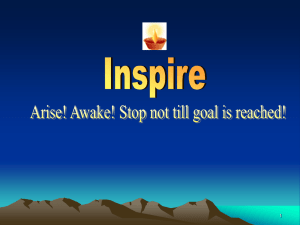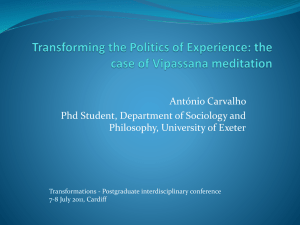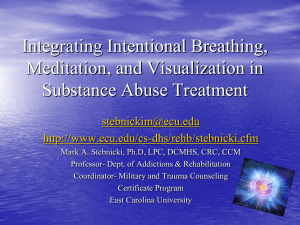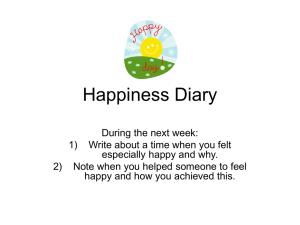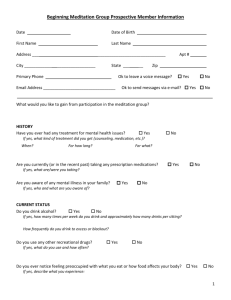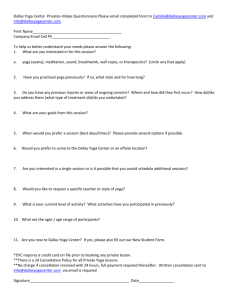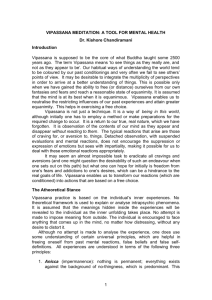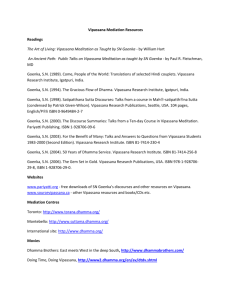AHEM Meditation, Neuroscience & Somatic Psych excerpt
advertisement
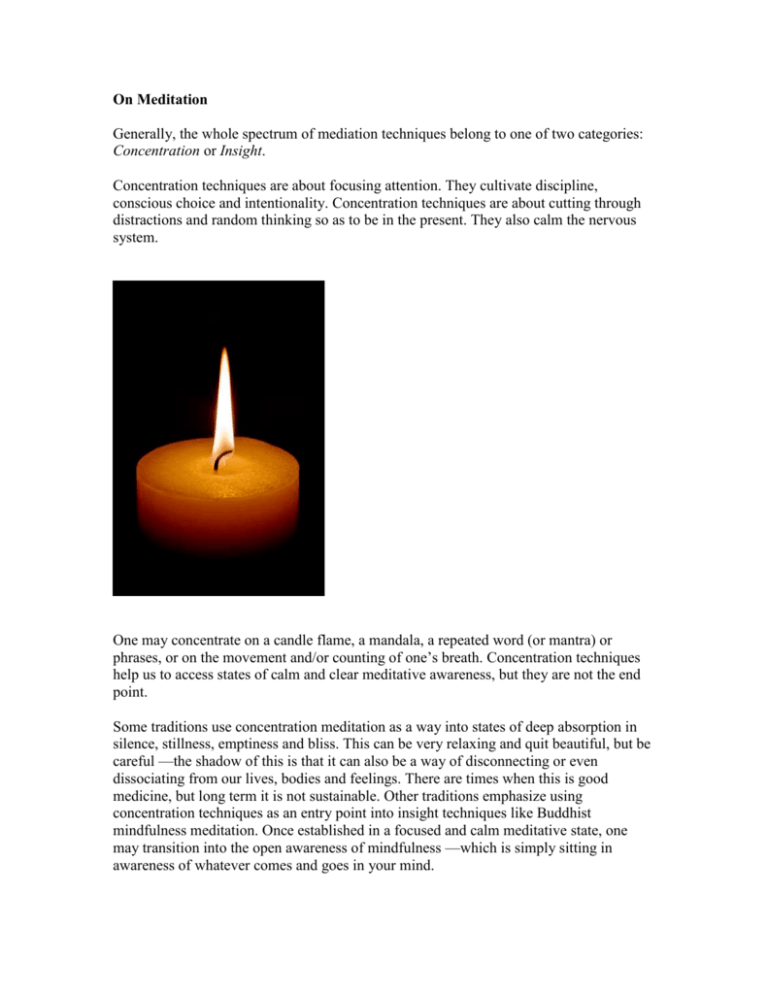
On Meditation Generally, the whole spectrum of mediation techniques belong to one of two categories: Concentration or Insight. Concentration techniques are about focusing attention. They cultivate discipline, conscious choice and intentionality. Concentration techniques are about cutting through distractions and random thinking so as to be in the present. They also calm the nervous system. One may concentrate on a candle flame, a mandala, a repeated word (or mantra) or phrases, or on the movement and/or counting of one’s breath. Concentration techniques help us to access states of calm and clear meditative awareness, but they are not the end point. Some traditions use concentration meditation as a way into states of deep absorption in silence, stillness, emptiness and bliss. This can be very relaxing and quit beautiful, but be careful —the shadow of this is that it can also be a way of disconnecting or even dissociating from our lives, bodies and feelings. There are times when this is good medicine, but long term it is not sustainable. Other traditions emphasize using concentration techniques as an entry point into insight techniques like Buddhist mindfulness meditation. Once established in a focused and calm meditative state, one may transition into the open awareness of mindfulness —which is simply sitting in awareness of whatever comes and goes in your mind. Rather than pushing away any thoughts, feelings, sounds or sensations, one simply is mindfully aware of these as they come and go. This kind of curious and open mindful attention becomes a space in which insights arise about the patterns of one’s own mind. Rather than staying in the concentration technique and blocking anything out, insight techniques use concentration to drop beneath the layers of static and chatter, but then turn with an open and loving attention toward whatever may be present in the deeper layers of the embodied mind. This promotes healing and growth in-and-of-itself, and strengthens our capacity for introspection, self-awareness, emotional honesty and being at home in our bodies and lives. The word “vipassana” literally translates as “insight.” This technique involves first actively scanning through the body and inviting an awareness of sensations, and then sitting in an open-ended mindful awareness of sensations and their related thoughts and feelings. In AHEM, we utilize focus on counting and feeling the breath as an initial concentration technique. We may also use Buddhist Loving-kindness meditation with its repeated phrases as a form of both accessing concentration, and engaging our emotional intelligence as a resource. May I be well May I be healthy and strong May I be happy and safe May I be free from suffering and what causes me to suffer May I be filled with compassion In addition we use the AHEM Love, Surrender, Peace, Forgiveness Meditation to access emotional intelligence and process while staying in a concentrated state. Breathing in I receive love Breathing out I surrender what I cannot control Breathing in I receive peace Breathing out I offer forgiveness From the states activated by engaging mental focus and heart opening, we bring attention to the sensation body using vipassana meditation. We want to encourage you to establish the goal of being able to sit in meditation for 20 – 40 minutes and use concentration techniques as a platform for insight/mindfulness techniques. More on vipassana later, but for now practice the following: Concentration Meditation: Sit in your meditation posture with eyes closed and silently count 1 as you inhale, then 2 as you exhale, 3 breathing in, and 4 breathing out —until you get to 10. Begin again at 1. See if you can make it to 10 three times without losing count and getting lost in thought. If you do lose count, begin again each time at 1 and focus your mind anew. Buddhist Loving-kindness Meditation: Use the phrases above slowly and silently, while feeling the energy implied by the words. Traditionally you start with yourself (May I be well, May I…) and then repeat the same phrases while thinking of someone you love (May Suzy be well, May she…), and then again for someone you feel neutral toward and finally for an enemy. At first do the easier stages of just doing Loving-kindness for yourself and maybe someone you love. It is a more advanced practice to cultivate Loving-kindness for a neutral person and especially for an enemy. Love, Surrender, Peace, Forgiveness: Can be used as an alternate for Loving-kindness. This can also get deeply healing if you allow the phrases be about specific issues in your life. After 10 or 15 minutes using these techniques, practice sitting in an open mindful awareness for another 5 or 10 minutes, simply bearing witness to your mind and body. Now please spend a few minutes writing about your experience of these three meditation techniques. Did they affect you in different ways? Did one work better for you than the others? Were there shifts in energy: i.e. sensations, emotions, mental states? Key Neuroscience Concepts In the last 20 years the rapidly advancing field of neuroscience has presented not only the most exciting breakthroughs in terms of understanding the human brain, but also a wonderful opportunity to consider spiritual practice and psychology through a scientific lens. Let’s start with some basics: Though pre-dating some of what follows, our first key concept involves the Autonomic Nervous System (ANS). This branch of the nervous system regulates and controls visceral functions. It interacts with the endocrine system and modulates our arousal and relaxation responses. The ANS is located in the sub-cortical instinctive reptilian brain stem and then extends through the body via the sympathetic and parasympathetic branches. Simply put, the sympathetic branch of the ANS activates the “fight or flight’ response. Recently this common term has been expanded to include “fight, flight or freeze.” The parasympathetic branch of the ANS activates the “rest and digest” response. Though these two branches can be over-stimulated and out of balance, bear in mind that they are always functioning together in a way that seeks balance or homeostasis. There are also many forms both of arousal (up-regulation) and relaxation (down-regulation) that are healthy, useful and good. Excitement, motivation, inspiration, athletic performance, and creativity all require the activation of the sympathetic nervous system —in fact it is stimulated a little each time we inhale, as is the parasympathetic each time we exhale! Sympathetic: Fight or Flight When we are stressed, traumatized, angry, afraid or excited the sympathetic branch of the ANS generates the release of adrenaline and cortisol, which in turn creates an increase in heart rate, as well as increased metabolism to spike blood sugar. In addition, blood flows from the core of the body to the periphery, pupils dilate, sweating begins, peristalsis is inhibited, immune function is inhibited and the bronchioles of the lungs dilate. This process prepares the body for action in the face of danger. It is an evolutionary response that prioritizes immediate survival by mobilizing all resources toward fighting or running away. When we can neither run away nor fight, the remaining option is to freeze and “play dead” in the hope that a predator might ignore us. Parasympathetic: Rest and Digest The parasympathetic branch of the ANS is activated when we feel safe and calm. Relaxation of muscles, constriction of pupils, blood flowing back into the core of the body from the periphery, increased digestion, glycogen synthesis, slowing down of heart rate, are all effects. In the “rest and digest” phase our immune systems are activated, cell repair begins and we recover from the physical cost of strenuous activity. Trauma = Overwhelming Stress Our stress response is as it was when we were hunter-gatherers. Even though we are no longer hunting, being hunted, or engaging in hand to hand combat with neighboring tribes, our bodies still respond to stress and trauma in the same ways. In our hyperstressful and over-stimulated society many people experience a high baseline of sympathetic nervous system activation as the norm. This can create anxiety, hypoglycemia, low immunity, digestive problems, chronic inflammation and ongoing weight gain, which can in turn lead to multiple health problems. Often this over active stress response has layers of unresolved trauma underneath it that have “set up” our systems to be easily triggered into hyper-vigilance and to spend very little time in deep rest and relaxation. The loss of homeostatic self-regulation created by stress or trauma and how we can regain this balance so as to be more healthy and integrated is a central theme of our work together. Becoming more aware of our embodied experience via attention to sensations, cultivating of resources and learning how to stay emotionally present is the foundation for regaining and sustaining optimal self-regulation. When we practice yoga in this way, we are literally making new and stronger connections that integrate different areas of the brain. These areas may have become weakly connected as a result of overwhelming experiences or a lack of resources in the form of support and empathy. The Triune Brain This is a widely accepted and useful way of dividing the brain in to three layers that have emerged during the evolutionary process. Triune means “three-part,” and consists of the reptilian, mammalian and neo-mammalian brains. These are sometimes also called the reptilian brain stem, limbic system and neo-cortex. Simply put, the reptilian brain stem is purely instinctive and is responsible for our automatic reactions, bodily functions, nervous system and endocrine processes. The limbic system is what we share with all other mammals and has to do with warm and fuzzy qualities like emotions, bonding, loyalty, love, need for affection and closeness etc. The neo-cortex is what makes us different than all other animals. It gives us reason, abstract thinking, mathematics, sophisticated capacities to remember the past and imagine the future whilst located in the present, complex problem solving, intentional focus, art and symbolism, spirituality etc. When we speak of being “integrated” we mean that these three areas of the brain have open feedback loops connecting our instinctive, emotional and rational functions. In neuroscience terms, yoga and meditation cultivate this kind of integration by bringing greater conscious awareness to our experience of emotions, sensations, beliefs and unconscious defense mechanisms. When we are grounded in our bodies, in touch with our healthy emotional core, and able to reason clearly, this is the subjective experience of our triune brain functioning in an integrated way. Feelings/Instincts without Reason When overwhelmed by stress, triggered into traumatic associations, or out of touch with the resource of compassionate self-awareness our brains can easily be “hijacked” by instinctive or emotional over-reactions. This is a state in which the self-aware executive control of the neo-cortex has been over-ridden. We are reactive, impulsive and unable to be self-aware. Reason without Feelings/Instincts Conversely, when we are defended against feeling our emotions and bodies, we can find ourselves cut-off from valuable information and resources within ourselves and in relation to others. In these states our limbic and reptilian systems are being repressed, while we maintain rigid beliefs or a cold “Mr. Spock”-like rationality. Our emotional, embodied intelligence is repressed. Un-integrated Spiritual Variations In the history of religion and spirituality there has been an understandable rejection of one or more of the aspects of our humanity as a way to try and overcome suffering. Because of the imperfect nature of the evolutionary process, the different areas of our brains can experience conflict between thinking, feeling and instinctive reactions. This has often led to a dualistic stance that assigns blame to either our animal nature (including our sexuality or other bodily needs), or our emotional need for love and connection with others, or our unique and powerful capacity to reason. If we could only get rid of one or more of these offending traits (goes the story), then we would be free! Some spiritual belief systems can perpetuate disconnecting from emotions and sensations by valuing a kind of aloof, superior sense of being beyond these worldly attachments. This over emphasis on trancendence misses integration by dissociating from our embodied and emotional experience —and (ironically) seeks relief and even salvation somewhere else! Other forms of spirituality encourage being disconnected from our capacity to reason, while valuing pure feeling and faith. This misses integration by devaluing the uniquely human capacities of the neo-cortex. Some spirituality even seems to suggest that we be not only emotionally and rationally disengaged, but that we also dis-identify from our bodies. Thus all three triune brain functions are held in suspicion as being unspiritual. Clearly this would also not facilitate integration. AHEM suggests rather that good medicine for the inherent conflicts of being human lies more in a compassionate and mindful embrace than in any attempt to overcome or disconnect from emotions, sexuality, aggression, pleasure, relationship, love, work, or thought. Our approach suggests that an integrated spirituality values all three essential aspects of our humanity (expressed by the triune brain) and seeks not only to develop them, but to also have them inform one another. We seek to awaken the mind, engage the heart, cultivate resources and have an in-the-body experience of aliveness and relationship to others and the world. Somatic Psychology, Neuroscience and Buddhist Vipassana Meditation Joseph Campbell once said, “People think we are looking for a meaning to life, but I think what we truly seek is an experience of being fully alive!” Being fully alive in an embodied way implies being in touch with the language of your inner world. While meaning is important, let’s focus for now on sensations and emotions. In the midst of all the philosophical complexity and variation within Buddhism (and let’s remember, the Buddha was a yogi) lies the centerpiece of the Buddha’s teaching: vipassana. The word vipassana means “insight,” and this practice is a powerful way to contemplate the nature of the human condition. One can go on ten day or even three-month silent Buddhist retreats and practice vipassana for eight to twelve hours a day, but we aren’t going to ask you to do that quite yet! The technique is very simple: pay attention to your sensations. Through slowing down the mind and becoming more aware of the body, a profound shift happens in how we relate to ourselves. By staying present with sensation we start to be able to track the cycles of tension and release, arousal and relaxation, pleasure and discomfort as they come and go in bodily experience. As we become more practiced in vipassana, we start to become more aware of ways we habitually contract in response to uncomfortable thoughts, feelings or memories. We start to literally experience how the mind lives in the body. The process of staying present with sensations then starts to reveal the emotional content of our physical experience, and a profound psychological/spiritual set of insights can emerge. This may include realizing where we have gotten stuck in our lives, or where we have shut down our capacity to love and be loved. We may see how recurrent themes in our lives are organized around specific events or dynamics that have kept us imprisoned and unconscious. Ultimately, vipassana is about developing an ability to be in compassionate awareness of all of our experience. While some traditional teachings in Buddhist, Yogic and Abrahamic religion teach a subtle or overt rejection of the body, vipassana meditation can be a wonderful tool for embracing, and healing our bodies. We bring a vipassana style of mindful, receptive awareness to yoga practice. Somatic psychology also teaches a focus on sensations. Becoming more aware of sensations is not only a way of grounding awareness in the body, but also of identifying both resources and trigger responses that have their roots in unresolved trauma. In somatic psychology, the emphasis on becoming more aware of sensations is about learning to stay present with the cycles our nervous system goes through. This enables us to more efficiently “titrate” the powerful charge that can be present in our bodies when we are triggered. In both approaches there is an appreciation of the language of sensation as a doorway into a process of healing and growth. In both approaches sensation often reveals itself as being linked with emotion and/or thoughts and memories. Staying present with sensations is understood as a way to come to insights, healing and integration. In neuroscience terms, we train the brain to be in a state of mindfulness when we choose again and again to stay present with sensations. We are being mindful of our bodies and breath and the moment to moment unfolding of the experience of sensations. This mindful state has been shown to activate neuroplasticity —our brain’s ability to transform not only function but also structure in response to experience. We literally enter a zone of transformational possibility at the level of the brain when we are in meditative states. We can be mindful in a variety of ways, but being mindful in relation to our bodies brings together a set of brain functions that make insight, compassion and integration possible in powerful ways. It also helps us to become more aware of our unconscious reactions so as to be less driven by them and have more of a gap between our triggers and how they make us act. AHEM brings yoga together with Buddhist vipassana meditation with the tools and approach of somatic psychology. We also use information from neuroscience about how input from our bodies is arranged on the somatosensory cortex of the brain. Rather than following the traditional vipassana approach of scanning for sensation from the crown of the head down, we work with the brain —first becoming aware of the hands —which are the easiest part of the body to feel. From the hands and fingers we move to the lips and tongue, sensing the face and scalp, jaw and base of the skull. Next we move into the belly and low back and then through the upper back, shoulders and chest, neck and throat. Pouring awareness down from shoulders through arms and into hands again. Next we take awareness all the way down to the feet and from there into the pelvis and hips, before connecting these two areas by feeling all the way through the legs. After spending some time getting tuned into sensation in this way and entering a mindful state, the next stage is to have an open awareness that is present but not focused in any particular region. This allows us to enter a more organic phase of vipassana, in which we pay attention to whichever sensations arise and stay with whatever process they go through. As we train our brains in this way through meditation, it deepens our capacity for embodied presence and emotional awareness while practicing yoga. You will also notice I use this somatic map for how I induct deep relaxation in savasana. Neuroplasticity The central mystery is consciousness: the relationship between mind and body, the origin and process of subjective experience. These questions remain confounding, but this is not to say we have not come a long way. While we are by all accounts humbled in the face of both the brain’s extraordinary complexity and the completely unique nature of consciousness, the last 25 years have been a period of exponential growth in our ability to look at these questions scientifically. Of course, yogis have been inquiring into consciousness for a very long time, but this is purely from the other side of the conversation. Spiritual practice is an entirely subjective affair, whilst science seeks objective evidence. In a way, consciousness is at the junction of subjectivity and objectivity. It has simultaneously a neurobiological substrate with neuronal and biochemical correlates we are slowly but steadily identifying and brain regions that are being mapped, and a mysteriously private 1st person expression. How exactly the two relate remains inscrutable, but the fact that they are inextricably related is undeniable. With lots of research being done on how practices that train us in mindfulness affect the brain, this dance between subjectivity and objectivity, spirituality and science is more fascinating and exciting than ever before. Far from negating the mysteries of consciousness, this feels like a celebratory exploration. Up until about 15 years ago it was thought that the brain was “hard-wired” by the age of five or six. But there has been a revolution in neuroscience, based in the discovery of how experience changes the brain’s function and even structure over time. This is called neuroplasticity. Any meaningful conversation about how yoga practice can effect transformation now has a reference point in brain research. What follows are AHEM’s Three Principles of Transformational Neuroplasticity, as gleaned from the current neuroscience literature. Consistency It is the repeated, consistent patterns created by new experience that change the brain, and therefore who we are, how we feel, how we deal with our emotions, how aware we are of our bodies and how integrated we are on all levels. The emphasis on consistency in all practice-based traditions is connected to the observation that staying on the path produces results over time. Proponents of spirituality have always understood this intuitively, but now we are closer to understanding why it works! Consistent practice is essential—it is where the rubber meets the road. From Rumi: Commit yourself to a daily practice, Your loyalty to that is like a ring on the door. Keep knocking and eventually the joy that lives inside Will look out to see who’s there… Linkage: “What Fires Together, Wires Together” This is a catchphrase from the research referring to the phenomenon of linkage between neural pathways. We can create powerful chains of association that form strong and complex neural networks with multiple links when we practice. Linking the experience of sitting down on our mats with activating breath awareness, and becoming grounded, resourced and oriented is one example of utilizing this principle. Each time we sit down to begin yoga we are stimulating this neural network until it is second nature. Linking the experience of being resourced to the experience of consciously and compassionately staying present with what scares us starts to change how we deal with stress and trauma in ourselves and in others. Linking the practice trinity of breath, presence and compassion similarly develops a new brain skill. Adding elements like music or poetic images can enrich this still further. Your Just Desserts: Utilizing the Reward System Mindfulness activates neuroplasticity, but when the reward system is firing, those new pathways grow even stronger. The reward system releases feel good chemicals like dopamine and endorphins. In the biochemical matrix created by the reward system, the possibilities of neuroplastic transformation are amplified. Deep breathing, music, poetry, communal experience and physical activity all stimulate the reward system —that’s why they make us feel good. So experiencing the process of inner work, resourcing, healing and even the discharge of emotional energy in contexts that also make us feel good, means that the transformational pathways will be formed that much more strongly. Enjoy being in your body when you are practicing, let the good feelings in, maintain a sense of connection to the community or tribe around you, radiate and receive compassion, permission, and gratitude and use all of this as fuel for the journey of shifting old patterns, healing wounds and learning new habits. From The Radiance Sutras: Rocking, swaying, undulating Carried by the rhythm, Ride the waves of ecstatic motion Into a sublime fusion of passion and peace. We think of the above three principles of transformational neuroplasticity as a doorway into the “sacred biochemistry” of yoga practice. They represent both a poetic and scienceinformed way of seeking to frame the experiential processes of self-transformation through yoga and meditation. The Mirror Neuron System First discovered accidentally, mirror neurons hold a potentially fascinating piece of the puzzle about empathy, compassion and why the shared experience of yoga practice can be so beneficial. On break in the lab, scientists noticed that the same neurons that lit up in a monkey’s brain when it reached for a banana lit up when it watched an experimenter reach for a banana —even as the monkey sat unmoving. It turns out that, like our cousin monkeys, we have brain cells that actually simulate in our own minds what we are watching someone else do. This may be part of how higher mammals became so good at learning new behaviors, but it may also hold the key to how we are able to feel care and concern for others. Not only do these mirror neurons allow us to imagine how it feels to perform an action, they are also stimulated when we watch someone being touched. But it gets better; there are mirror neurons that simulate the emotional states of others within our own brains. Interestingly, there is research showing that the more we exercise our motor mirror neurons, the more our emotional mirror neurons may also be strengthened. In yoga class we emulate the postural details of the teacher and we synchronize our movements with our fellow students. This creates a shared experience of breath and posture that powerfully engages not only a tribal sense of belonging, but also a shared experience via the mirror neuron system. This shared experience of movement can also be infused with a shared emotional experience. We ride the wave together of warming up, working hard, having peak moments, and cooling down into rest and meditation. This energetic arc may also include space for compassion toward one another, especially if the space is held in a way that permits deep feeling. In a culture that is often uncomfortable with (or judgmental toward) vulnerability and emotional open-ness, the communal sacred space of yoga can foster permission to trust our emotional intelligence and feel the connection that comes from being empathic toward our fellow yogis. The mirror neurons are already a key component of practicing yoga, but recognizing the connection between shared physical experience and emotional resonance can make for an even richer and more transformational space. Memory, Trauma, Triggers & Healing For the purpose of our discussion, let’s talk about memory as being processed at each level of the triune brain. This is a very simplified version of a complex process. In the amygdala, an early part of the limbic system closely related to the reptilian brain, memory is stored in a primal, impressionistic way. This brain structure is most commonly associated with fear and aggression. In the hippocampus, part of the limbic brain, memory is stored in a slightly more integrated way by incorporating more information about time and place, sense of self and emotional nuances. At the level of the neo-cortex, memory is stored in a way that now includes the information from the previous two levels, but also can see the memory in the context of our life story and how it has shaped or informed who we are. Implicit, Explicit & Narrative Memory When memory is stored at the level of the amygdala it is called implicit memory, and has a primal, unconscious, un-integrated quality to it. When memory is stored at the level of the hippocampus, it is called explicit memory because it contains more of the “tags” for time and place, sense of self and perhaps more nuanced emotional content than the purely primal energy of the amygdala. When memory is integrated at the level of the neo-cortex it is called narrative memory. Being Triggered & The Opportunity for Healing A fascinating and important thing happens when we are under the kind of overwhelming stress or trauma that, in some form, are part of every human life. The activation of the ANS and ensuing release of adrenaline and cortisol actually shuts down the hippocampus. This prevents the memories of the event from being integrated at the level of the hippocampus or the neocortex. Memories of traumatizing events are very often stored either partially or completely in the amygdala. This means that when we are “triggered” by an association or a stimulus, we are vulnerable to being flooded by the primal energies and feelings of this experience, but we often don’t recognize this as a memory, because it has no time and place content. When we are triggered into an implicit memory, we feel as if the experience is happening right now. There may not be much content to the memory, just intense activation of nervous system responses and a feeling that we have to fight, flee or freeze. All of us are familiar with the experience of having a reaction that is out of proportion to the situation we are in, or to having an irrational fear of certain experiences. We very often unconsciously limit our life choices and self-concept based on avoiding or defending against triggers that bring up past traumas. We also know what it is like to be interacting with someone and suddenly have them start reacting in overly intense ways to something we have said or done. This is part of being human, and often comes up most powerfully in our closest relationships, because these trigger our unconscious implicit memories of family dynamics and childhood trauma. Most of us tend to blame the current situation or person for what is being triggered until we learn to become more skillful at separating out what is present and what is past. It is very common for us to judge ourselves and others when triggered, and many conventional as well as spiritual attitudes will relay the message to either get control of ourselves, stop being self-indulgent, quit playing the victim etc… However, when we are triggered something is happening in a very core and primal part of ourselves, and it is not a simple task to over-ride a powerful survival mechanism gone awry. It is also an opportunity to deepen self-knowledge and grow in awareness and compassion by healing and integrating a past experience that has had an unconscious hold over our lives. Over time and with practice, triggers can be seen as the most valuable signposts we have to where the real spiritual work is. One we learn to stay present with triggers, either in the situation itself, or more easily in the safe and resourced context of meditation, yoga, therapy or bodywork, we can allow the integration process to literally up-level through the hippocampus and the neo-cortex, thus freeing ourselves of the power held in the un-integrated charge of implicit memory. When this work has happened effectively, what used to trigger us is no longer a problem. The Gift of “Doing the Work” As we stay present with a triggered implicit memory, stay grounded, oriented and resourced in ourselves, and discharge the activated energy, what often happens is that we start to get insight about the time and place content of the memory as well as the sense of self and emotional nuances that were present. It is a powerful “Aha!” moment when we realize that a reaction we have comes from a specific time and age in our lives and is related to a specific experience or dynamic that had a painful effect on us. In the supportive context of a safe and resourced space we can process through this and see the narrative pattern in our lives, thus becoming more conscious of what was before an unconscious force driving our behavior. This is the key moment that defines meaningful growth and healing. Skillfully embracing such moments and supporting others in doing so as well is at the heart of being an Awakened Heat, Embodied Mind teacher. Working through our triggers is a way to become more integrated, responsive, and self-aware. It allows us to be more compassionate, to communicate better and to become more empowered, loving and courageous in our lives. It also allows us to relinquish limiting defenses that in the past had protected us from unresolved feelings and un-integrated experiences. Every time we teach a yoga class we are meeting with our community in sacred space and everything is there beneath the surface, whether we acknowledge it or not. Trauma, suffering, painful feelings, anxiety, grief, rage and shame are all in the room. Often, these aspects of our experience are looked down upon, feared, pushed away. We have an aversion to being present with them and to admitting that they are part of our lives. We even come up with “spiritual” ways to deny or judge, rationalize or dissociate our way out of finding the love and the courage to get real with ourselves. Rather than perpetuating this we can share tools and ideas with people in a supportive group setting that allow space for authentic process and encourage people to stay truly present, develop real compassion and find ways to genuinely transform their lives from the inside. This requires that we “do the work” ourselves. There is still fun and joy and playfulness, still the bliss and ecstasy of practice – but these can be seen as resources to support us in facing what scares us. These positive, soulful qualities can also be even more deeply appreciated as we become free of our fear of the shadow.

